Abstract
The objective of this review is to summarize recent data on the genetics of autism, highlight the evidence for genetic heterogeneity and extend the implications of these findings for the identification of susceptibility genes in this disorder. Family studies have shown that autism runs in families and twin studies indicate that the basis of that familial aggregation is genetic. As a result the prospects for the identification of susceptibility genes using either linkage or association studies are quite good. However, recent evidence is accumulating suggesting that the disorder is genetically heterogeneous; higher functioning individuals with autism may arise from separate genetic mechanisms that lower functioning ones. If true, this will make the detection of linkage and association much more difficult.
Full text
PDF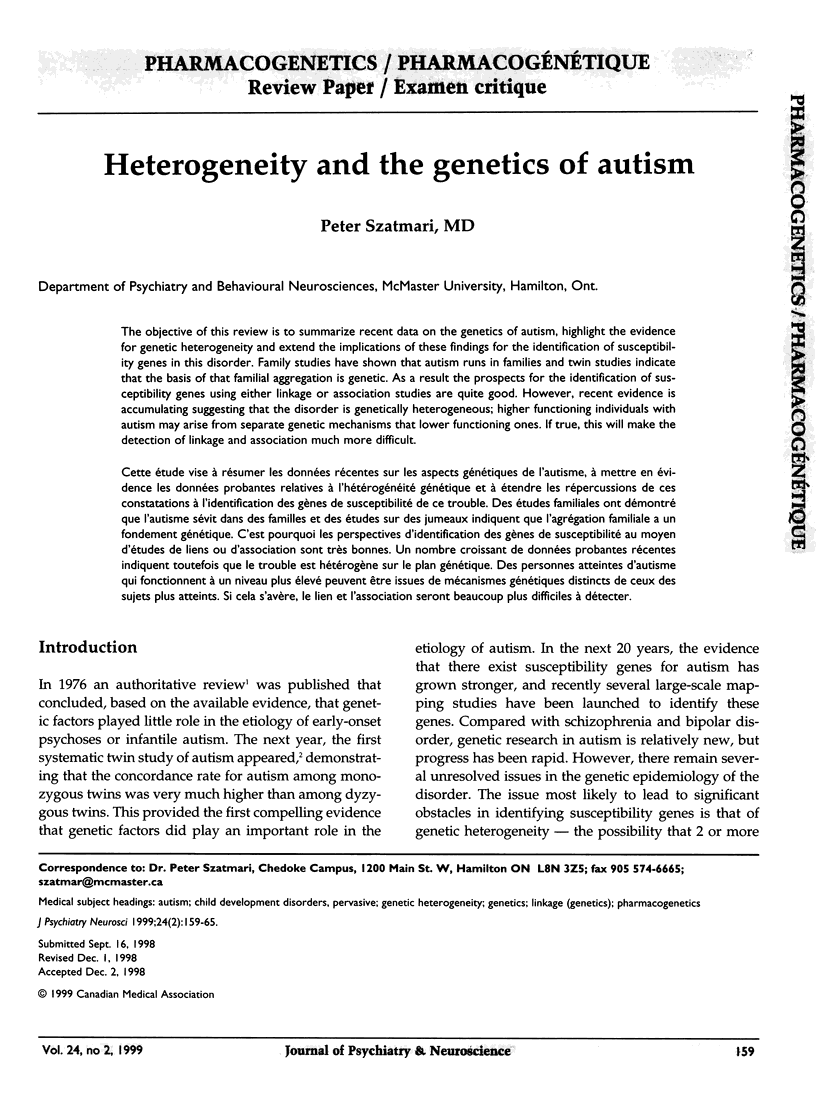
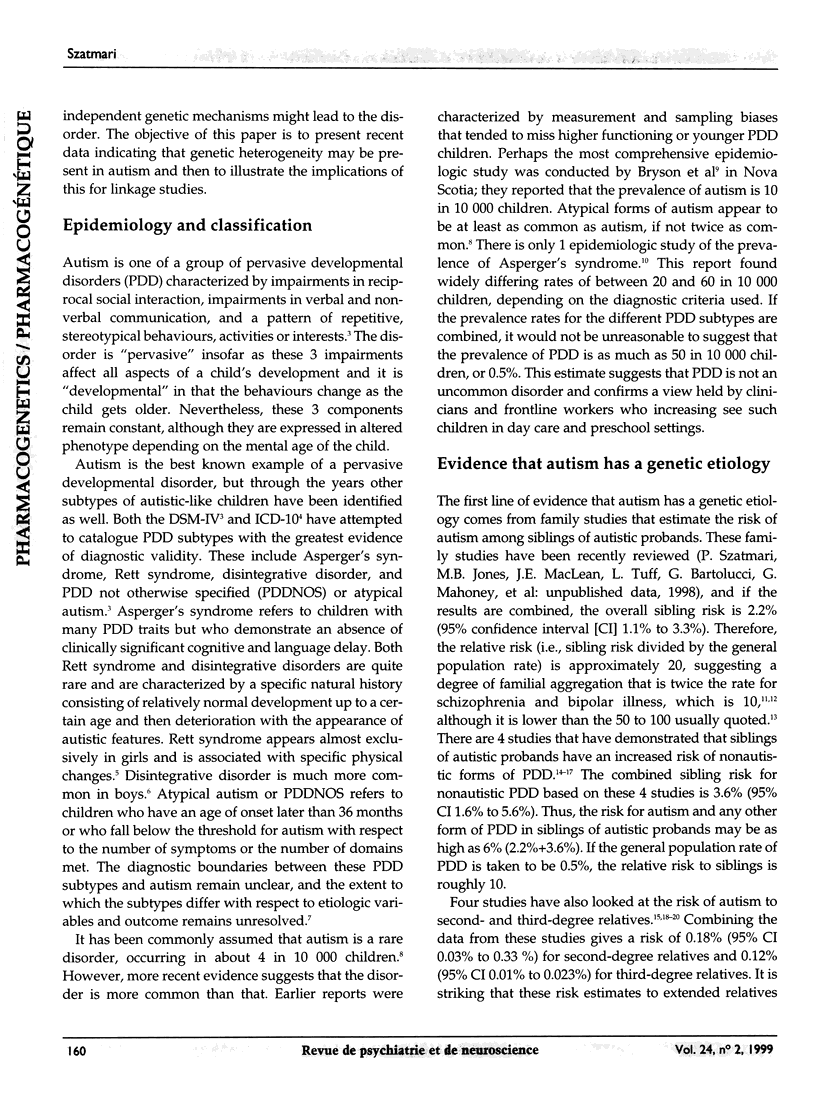
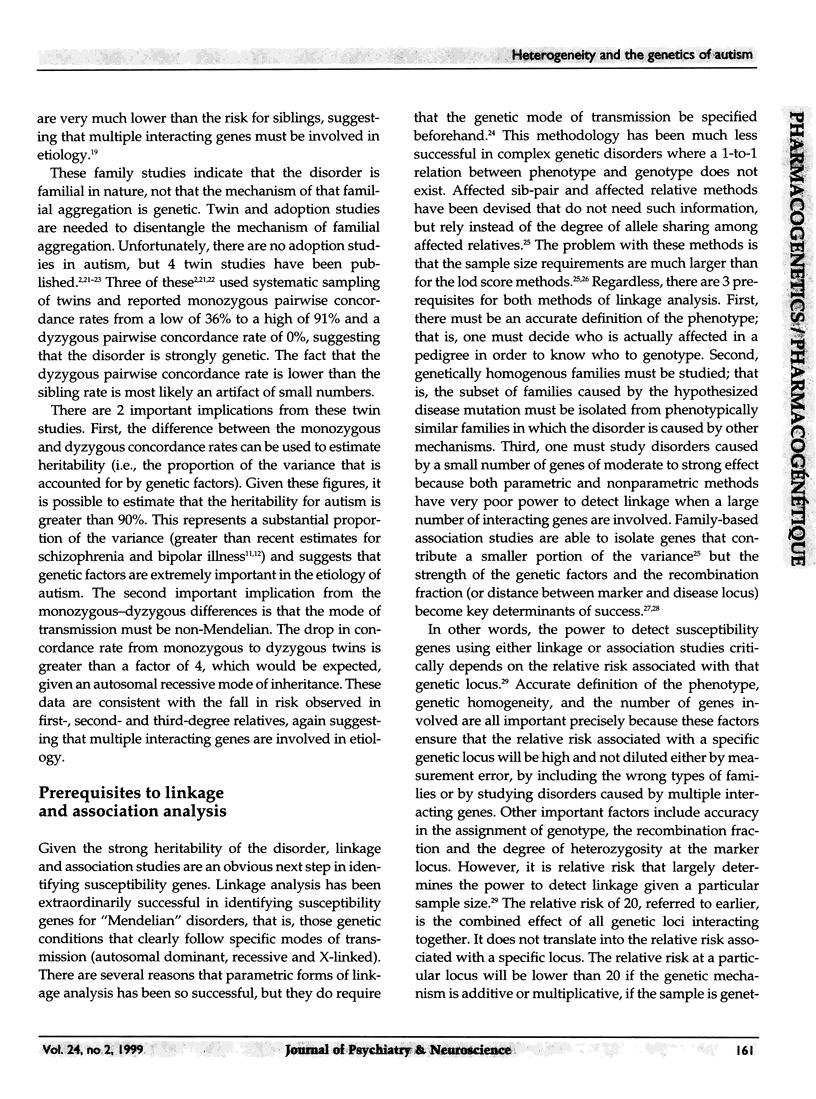
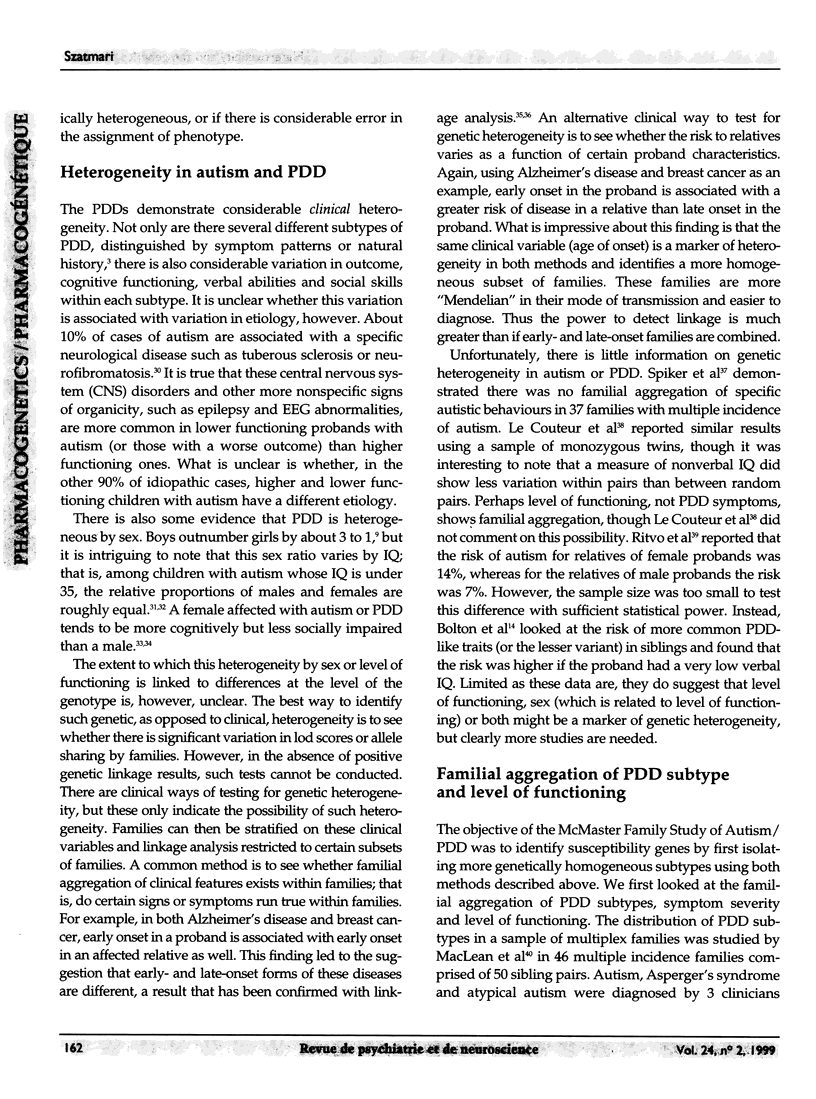
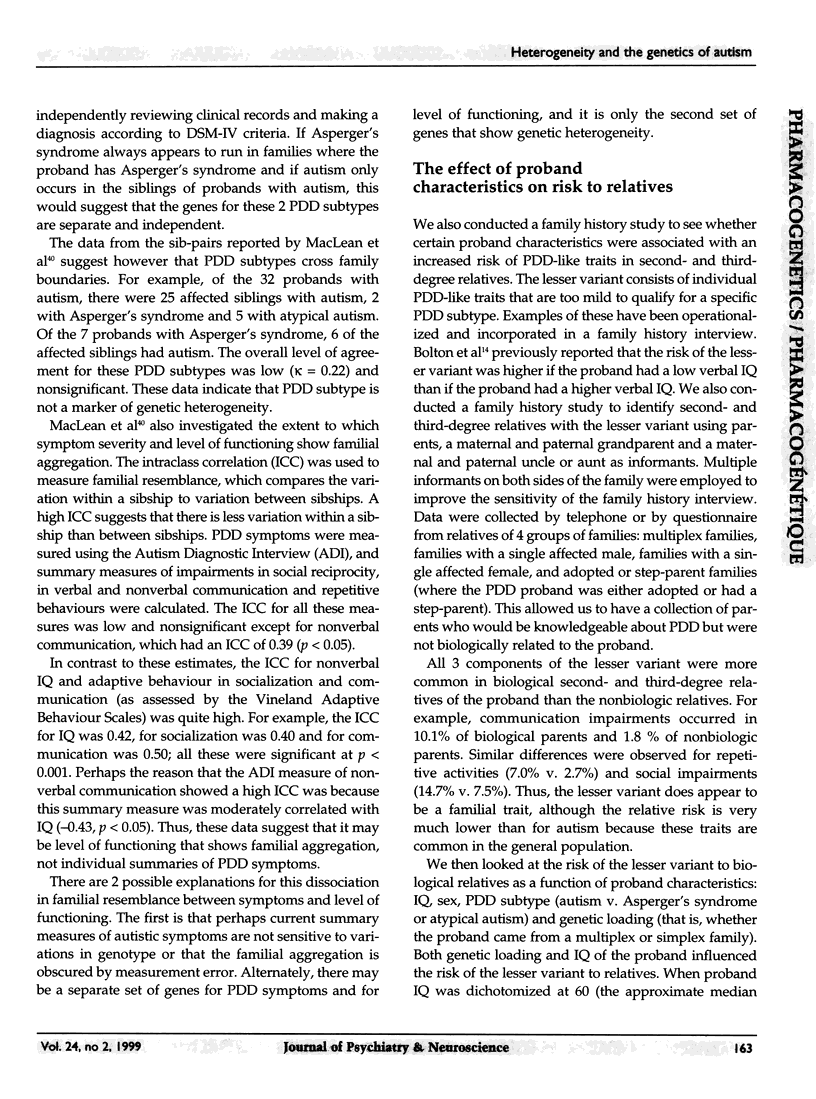
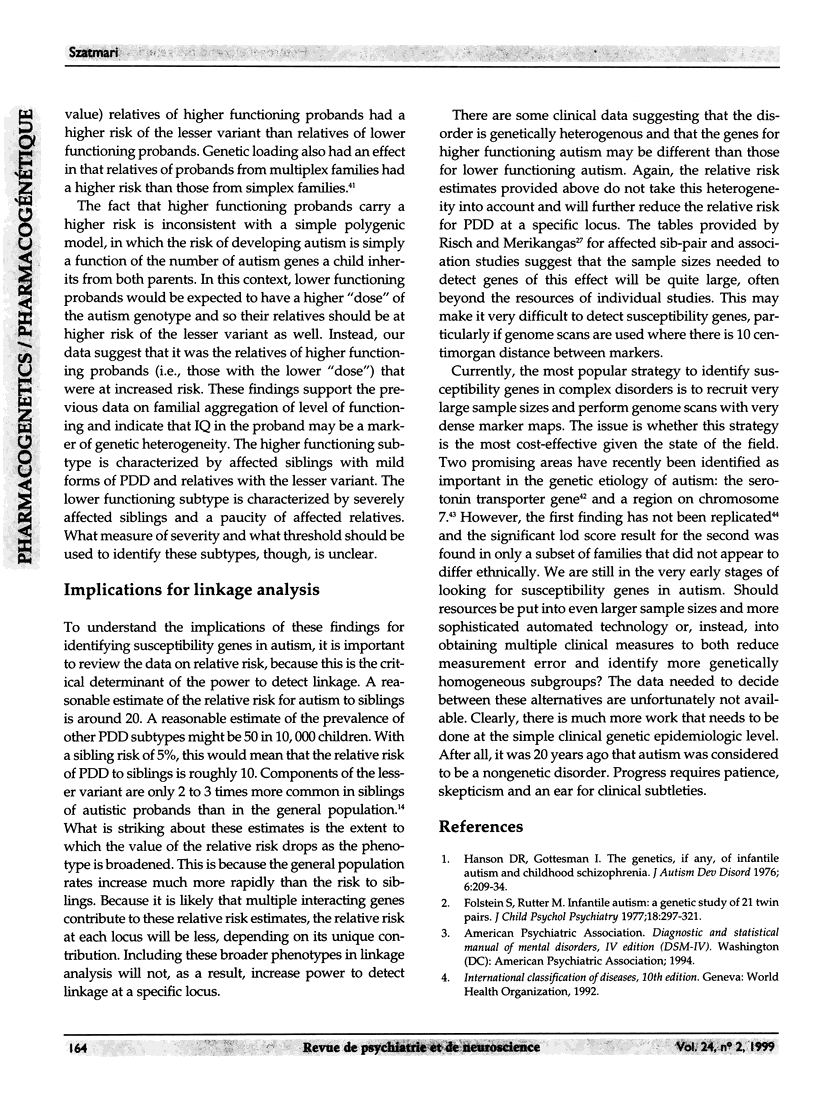
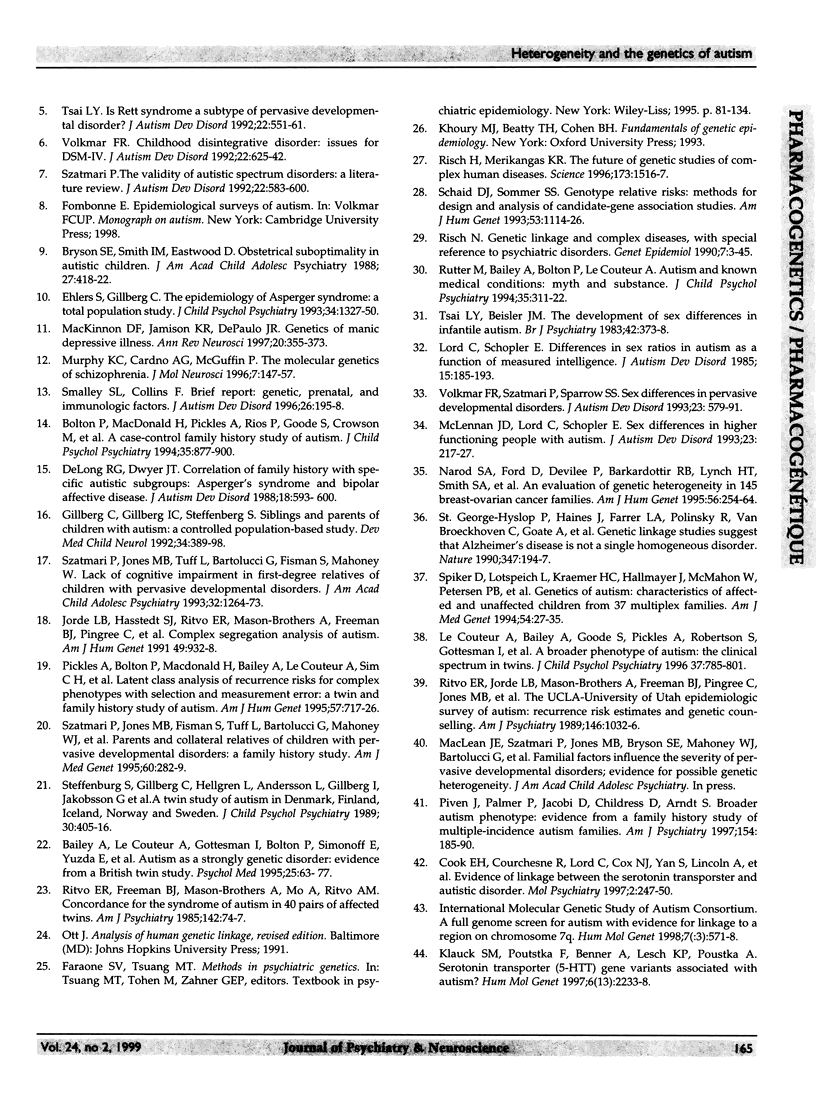
Selected References
These references are in PubMed. This may not be the complete list of references from this article.
- Bailey A., Le Couteur A., Gottesman I., Bolton P., Simonoff E., Yuzda E., Rutter M. Autism as a strongly genetic disorder: evidence from a British twin study. Psychol Med. 1995 Jan;25(1):63–77. doi: 10.1017/s0033291700028099. [DOI] [PubMed] [Google Scholar]
- Bolton P., Macdonald H., Pickles A., Rios P., Goode S., Crowson M., Bailey A., Rutter M. A case-control family history study of autism. J Child Psychol Psychiatry. 1994 Jul;35(5):877–900. doi: 10.1111/j.1469-7610.1994.tb02300.x. [DOI] [PubMed] [Google Scholar]
- Bryson S. E., Smith I. M., Eastwood D. Obstetrical suboptimality in autistic children. J Am Acad Child Adolesc Psychiatry. 1988 Jul;27(4):418–422. doi: 10.1097/00004583-198807000-00006. [DOI] [PubMed] [Google Scholar]
- Cook E. H., Jr, Courchesne R., Lord C., Cox N. J., Yan S., Lincoln A., Haas R., Courchesne E., Leventhal B. L. Evidence of linkage between the serotonin transporter and autistic disorder. Mol Psychiatry. 1997 May;2(3):247–250. doi: 10.1038/sj.mp.4000266. [DOI] [PubMed] [Google Scholar]
- DeLong G. R., Dwyer J. T. Correlation of family history with specific autistic subgroups: Asperger's syndrome and bipolar affective disease. J Autism Dev Disord. 1988 Dec;18(4):593–600. doi: 10.1007/BF02211877. [DOI] [PubMed] [Google Scholar]
- Ehlers S., Gillberg C. The epidemiology of Asperger syndrome. A total population study. J Child Psychol Psychiatry. 1993 Nov;34(8):1327–1350. doi: 10.1111/j.1469-7610.1993.tb02094.x. [DOI] [PubMed] [Google Scholar]
- Folstein S., Rutter M. Infantile autism: a genetic study of 21 twin pairs. J Child Psychol Psychiatry. 1977 Sep;18(4):297–321. doi: 10.1111/j.1469-7610.1977.tb00443.x. [DOI] [PubMed] [Google Scholar]
- Gillberg C., Gillberg I. C., Steffenburg S. Siblings and parents of children with autism: a controlled population-based study. Dev Med Child Neurol. 1992 May;34(5):389–398. doi: 10.1111/j.1469-8749.1992.tb11450.x. [DOI] [PubMed] [Google Scholar]
- Hanson D. R., Gottesman I. I. The genetics, if any, of infantile autism and childhood schizophrenia. J Autism Child Schizophr. 1976 Sep;6(3):209–234. doi: 10.1007/BF01543463. [DOI] [PubMed] [Google Scholar]
- Jorde L. B., Hasstedt S. J., Ritvo E. R., Mason-Brothers A., Freeman B. J., Pingree C., McMahon W. M., Petersen B., Jenson W. R., Mo A. Complex segregation analysis of autism. Am J Hum Genet. 1991 Nov;49(5):932–938. [PMC free article] [PubMed] [Google Scholar]
- Klauck S. M., Poustka F., Benner A., Lesch K. P., Poustka A. Serotonin transporter (5-HTT) gene variants associated with autism? Hum Mol Genet. 1997 Dec;6(13):2233–2238. doi: 10.1093/hmg/6.13.2233. [DOI] [PubMed] [Google Scholar]
- Le Couteur A., Bailey A., Goode S., Pickles A., Robertson S., Gottesman I., Rutter M. A broader phenotype of autism: the clinical spectrum in twins. J Child Psychol Psychiatry. 1996 Oct;37(7):785–801. doi: 10.1111/j.1469-7610.1996.tb01475.x. [DOI] [PubMed] [Google Scholar]
- Lord C., Schopler E. Differences in sex ratios in autism as a function of measured intelligence. J Autism Dev Disord. 1985 Jun;15(2):185–193. doi: 10.1007/BF01531604. [DOI] [PubMed] [Google Scholar]
- MacKinnon D. F., Jamison K. R., DePaulo J. R. Genetics of manic depressive illness. Annu Rev Neurosci. 1997;20:355–373. doi: 10.1146/annurev.neuro.20.1.355. [DOI] [PubMed] [Google Scholar]
- McLennan J. D., Lord C., Schopler E. Sex differences in higher functioning people with autism. J Autism Dev Disord. 1993 Jun;23(2):217–227. doi: 10.1007/BF01046216. [DOI] [PubMed] [Google Scholar]
- Murphy K. C., Cardno A. G., McGuffin P. The molecular genetics of schizophrenia. J Mol Neurosci. 1996 Summer;7(2):147–157. doi: 10.1007/BF02736794. [DOI] [PubMed] [Google Scholar]
- Narod S. A., Ford D., Devilee P., Barkardottir R. B., Lynch H. T., Smith S. A., Ponder B. A., Weber B. L., Garber J. E., Birch J. M. An evaluation of genetic heterogeneity in 145 breast-ovarian cancer families. Breast Cancer Linkage Consortium. Am J Hum Genet. 1995 Jan;56(1):254–264. [PMC free article] [PubMed] [Google Scholar]
- Pickles A., Bolton P., Macdonald H., Bailey A., Le Couteur A., Sim C. H., Rutter M. Latent-class analysis of recurrence risks for complex phenotypes with selection and measurement error: a twin and family history study of autism. Am J Hum Genet. 1995 Sep;57(3):717–726. [PMC free article] [PubMed] [Google Scholar]
- Piven J., Palmer P., Jacobi D., Childress D., Arndt S. Broader autism phenotype: evidence from a family history study of multiple-incidence autism families. Am J Psychiatry. 1997 Feb;154(2):185–190. doi: 10.1176/ajp.154.2.185. [DOI] [PubMed] [Google Scholar]
- Risch N. Genetic linkage and complex diseases, with special reference to psychiatric disorders. Genet Epidemiol. 1990;7(1):3–45. doi: 10.1002/gepi.1370070103. [DOI] [PubMed] [Google Scholar]
- Risch N., Merikangas K. The future of genetic studies of complex human diseases. Science. 1996 Sep 13;273(5281):1516–1517. doi: 10.1126/science.273.5281.1516. [DOI] [PubMed] [Google Scholar]
- Ritvo E. R., Freeman B. J., Mason-Brothers A., Mo A., Ritvo A. M. Concordance for the syndrome of autism in 40 pairs of afflicted twins. Am J Psychiatry. 1985 Jan;142(1):74–77. doi: 10.1176/ajp.142.1.74. [DOI] [PubMed] [Google Scholar]
- Ritvo E. R., Jorde L. B., Mason-Brothers A., Freeman B. J., Pingree C., Jones M. B., McMahon W. M., Petersen P. B., Jenson W. R., Mo A. The UCLA-University of Utah epidemiologic survey of autism: recurrence risk estimates and genetic counseling. Am J Psychiatry. 1989 Aug;146(8):1032–1036. doi: 10.1176/ajp.146.8.1032. [DOI] [PubMed] [Google Scholar]
- Rutter M., Bailey A., Bolton P., Le Couteur A. Autism and known medical conditions: myth and substance. J Child Psychol Psychiatry. 1994 Feb;35(2):311–322. doi: 10.1111/j.1469-7610.1994.tb01164.x. [DOI] [PubMed] [Google Scholar]
- Schaid D. J., Sommer S. S. Genotype relative risks: methods for design and analysis of candidate-gene association studies. Am J Hum Genet. 1993 Nov;53(5):1114–1126. [PMC free article] [PubMed] [Google Scholar]
- Smalley S. L., Collins F. Brief report: genetic, prenatal, and immunologic factors. J Autism Dev Disord. 1996 Apr;26(2):195–198. doi: 10.1007/BF02172011. [DOI] [PubMed] [Google Scholar]
- Spiker D., Lotspeich L., Kraemer H. C., Hallmayer J., McMahon W., Petersen P. B., Nicholas P., Pingree C., Wiese-Slater S., Chiotti C. Genetics of autism: characteristics of affected and unaffected children from 37 multiplex families. Am J Med Genet. 1994 Mar 15;54(1):27–35. doi: 10.1002/ajmg.1320540107. [DOI] [PubMed] [Google Scholar]
- St George-Hyslop P. H., Haines J. L., Farrer L. A., Polinsky R., Van Broeckhoven C., Goate A., McLachlan D. R., Orr H., Bruni A. C., Sorbi S. Genetic linkage studies suggest that Alzheimer's disease is not a single homogeneous disorder. Nature. 1990 Sep 13;347(6289):194–197. doi: 10.1038/347194a0. [DOI] [PubMed] [Google Scholar]
- Steffenburg S., Gillberg C., Hellgren L., Andersson L., Gillberg I. C., Jakobsson G., Bohman M. A twin study of autism in Denmark, Finland, Iceland, Norway and Sweden. J Child Psychol Psychiatry. 1989 May;30(3):405–416. doi: 10.1111/j.1469-7610.1989.tb00254.x. [DOI] [PubMed] [Google Scholar]
- Szatmari P., Jones M. B., Fisman S., Tuff L., Bartolucci G., Mahoney W. J., Bryson S. E. Parents and collateral relatives of children with pervasive developmental disorders: a family history study. Am J Med Genet. 1995 Aug 14;60(4):282–289. doi: 10.1002/ajmg.1320600405. [DOI] [PubMed] [Google Scholar]
- Szatmari P., Jones M. B., Tuff L., Bartolucci G., Fisman S., Mahoney W. Lack of cognitive impairment in first-degree relatives of children with pervasive developmental disorders. J Am Acad Child Adolesc Psychiatry. 1993 Nov;32(6):1264–1273. doi: 10.1097/00004583-199311000-00022. [DOI] [PubMed] [Google Scholar]
- Szatmari P. The validity of autistic spectrum disorders: a literature review. J Autism Dev Disord. 1992 Dec;22(4):583–600. doi: 10.1007/BF01046329. [DOI] [PubMed] [Google Scholar]
- Tsai L. Y., Beisler J. M. The development of sex differences in infantile autism. Br J Psychiatry. 1983 Apr;142:373–378. doi: 10.1192/bjp.142.4.373. [DOI] [PubMed] [Google Scholar]
- Tsai L. Y. Is Rett syndrome a subtype of pervasive developmental disorders? J Autism Dev Disord. 1992 Dec;22(4):551–561. doi: 10.1007/BF01046327. [DOI] [PubMed] [Google Scholar]
- Volkmar F. R. Childhood disintegrative disorder: issues for DSM-IV. J Autism Dev Disord. 1992 Dec;22(4):625–642. doi: 10.1007/BF01046331. [DOI] [PubMed] [Google Scholar]
- Volkmar F. R., Szatmari P., Sparrow S. S. Sex differences in pervasive developmental disorders. J Autism Dev Disord. 1993 Dec;23(4):579–591. doi: 10.1007/BF01046103. [DOI] [PubMed] [Google Scholar]


